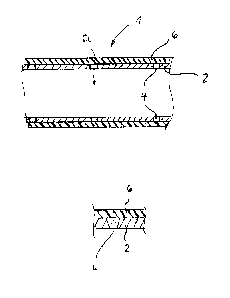Une partie des informations de ce site Web a été fournie par des sources externes. Le gouvernement du Canada n'assume aucune responsabilité concernant la précision, l'actualité ou la fiabilité des informations fournies par les sources externes. Les utilisateurs qui désirent employer cette information devraient consulter directement la source des informations. Le contenu fourni par les sources externes n'est pas assujetti aux exigences sur les langues officielles, la protection des renseignements personnels et l'accessibilité.
L'apparition de différences dans le texte et l'image des Revendications et de l'Abrégé dépend du moment auquel le document est publié. Les textes des Revendications et de l'Abrégé sont affichés :
| (12) Brevet: | (11) CA 2657713 |
|---|---|
| (54) Titre français: | LIGNE DE DETECTION PERMETTANT DE CONTROLER ET DE LOCALISER DES FUITES, ET METHODE DE REALISATION |
| (54) Titre anglais: | SENSOR LINE FOR MONITORING AND LOCATING LEAKS AND METHOD FOR PRODUCING SAME |
| Statut: | Accordé et délivré |
| (51) Classification internationale des brevets (CIB): |
|
|---|---|
| (72) Inventeurs : |
|
| (73) Titulaires : |
|
| (71) Demandeurs : |
|
| (74) Agent: | SMART & BIGGAR LP |
| (74) Co-agent: | |
| (45) Délivré: | 2016-04-19 |
| (22) Date de dépôt: | 2009-03-10 |
| (41) Mise à la disponibilité du public: | 2009-09-18 |
| Requête d'examen: | 2014-02-07 |
| Licence disponible: | S.O. |
| Cédé au domaine public: | S.O. |
| (25) Langue des documents déposés: | Anglais |
| Traité de coopération en matière de brevets (PCT): | Non |
|---|
| (30) Données de priorité de la demande: | ||||||
|---|---|---|---|---|---|---|
|
Une ligne de détection sert à surveiller et localiser les fuites dans une installation, dans laquelle, en cas de fuite, le chlore s'échappe dans lenvironnement du système, qui comprend un conduit de transport (2) dont la paroi comporte des ouvertures (4) qui sont scellées à laide dau moins une couche (6) qui est perméable au chlore (Cl), ladite couche étant faite dun caoutchouc siloxane comportant un halogène.
A sensor line for monitoring and locating leaks of an installation, in which, in the event of a leak, chlorine esapes into the environment of the system, comprises a carrier pipe (2) whose wall is provided with openings (4) which are sealed with at least one layer (6) that is permeable to chlorine (Cl), said layer consisting of a siloxane rubber containing a halogen.
Note : Les revendications sont présentées dans la langue officielle dans laquelle elles ont été soumises.
Note : Les descriptions sont présentées dans la langue officielle dans laquelle elles ont été soumises.

2024-08-01 : Dans le cadre de la transition vers les Brevets de nouvelle génération (BNG), la base de données sur les brevets canadiens (BDBC) contient désormais un Historique d'événement plus détaillé, qui reproduit le Journal des événements de notre nouvelle solution interne.
Veuillez noter que les événements débutant par « Inactive : » se réfèrent à des événements qui ne sont plus utilisés dans notre nouvelle solution interne.
Pour une meilleure compréhension de l'état de la demande ou brevet qui figure sur cette page, la rubrique Mise en garde , et les descriptions de Brevet , Historique d'événement , Taxes périodiques et Historique des paiements devraient être consultées.
| Description | Date |
|---|---|
| Représentant commun nommé | 2019-10-30 |
| Représentant commun nommé | 2019-10-30 |
| Lettre envoyée | 2019-02-21 |
| Inactive : Transferts multiples | 2019-02-06 |
| Accordé par délivrance | 2016-04-19 |
| Inactive : Page couverture publiée | 2016-04-18 |
| Inactive : Taxe finale reçue | 2016-02-10 |
| Préoctroi | 2016-02-10 |
| Requête visant le maintien en état reçue | 2015-12-30 |
| Un avis d'acceptation est envoyé | 2015-10-09 |
| Lettre envoyée | 2015-10-09 |
| Un avis d'acceptation est envoyé | 2015-10-09 |
| Inactive : Approuvée aux fins d'acceptation (AFA) | 2015-10-01 |
| Inactive : Q2 réussi | 2015-10-01 |
| Modification reçue - modification volontaire | 2015-09-14 |
| Inactive : Dem. de l'examinateur par.30(2) Règles | 2015-06-17 |
| Inactive : Rapport - Aucun CQ | 2015-06-09 |
| Requête pour le changement d'adresse ou de mode de correspondance reçue | 2015-01-15 |
| Lettre envoyée | 2014-02-19 |
| Exigences pour une requête d'examen - jugée conforme | 2014-02-07 |
| Toutes les exigences pour l'examen - jugée conforme | 2014-02-07 |
| Requête d'examen reçue | 2014-02-07 |
| Lettre envoyée | 2013-07-23 |
| Lettre envoyée | 2013-07-23 |
| Modification reçue - modification volontaire | 2012-01-10 |
| Modification reçue - modification volontaire | 2011-07-05 |
| Inactive : Page couverture publiée | 2009-10-02 |
| Demande publiée (accessible au public) | 2009-09-18 |
| Inactive : CIB en 1re position | 2009-08-21 |
| Inactive : CIB attribuée | 2009-08-21 |
| Demande reçue - nationale ordinaire | 2009-04-03 |
| Exigences de dépôt - jugé conforme | 2009-04-03 |
| Inactive : Certificat de dépôt - Sans RE (Anglais) | 2009-04-03 |
| Modification reçue - modification volontaire | 2009-03-10 |
Il n'y a pas d'historique d'abandonnement
Le dernier paiement a été reçu le 2015-12-30
Avis : Si le paiement en totalité n'a pas été reçu au plus tard à la date indiquée, une taxe supplémentaire peut être imposée, soit une des taxes suivantes :
Veuillez vous référer à la page web des taxes sur les brevets de l'OPIC pour voir tous les montants actuels des taxes.
Les titulaires actuels et antérieures au dossier sont affichés en ordre alphabétique.
| Titulaires actuels au dossier |
|---|
| FRAMATOME GMBH |
| Titulaires antérieures au dossier |
|---|
| JAN ZACH |
| PATRICK FLEISCHER |
| WALTER KNOBLACH |